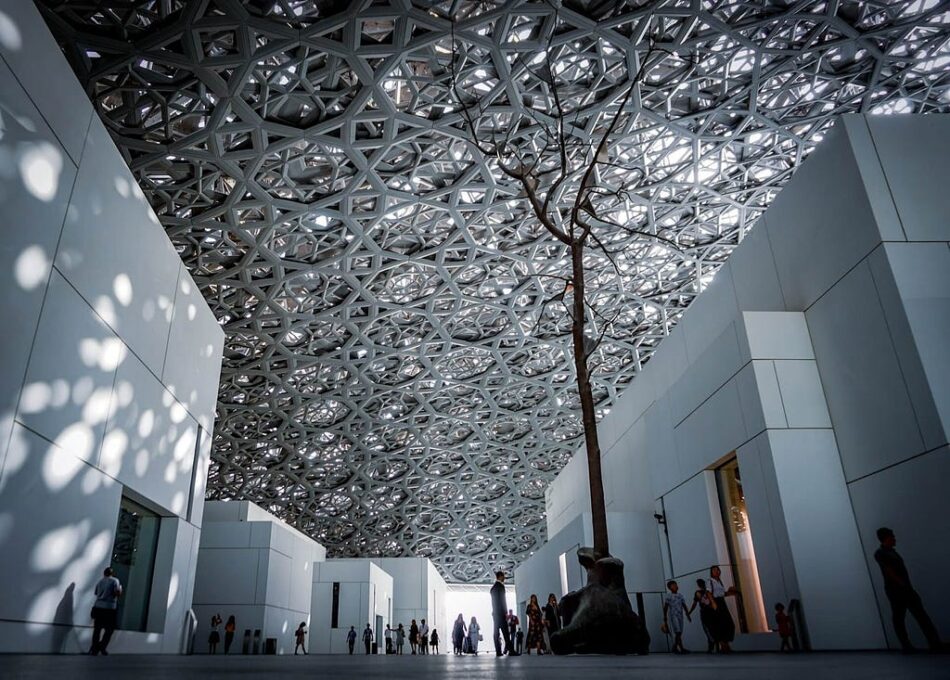Subtle, constrained, repetitive — and divine.
Ceiling of Abu Dhabi’s Louvre museum
Arabesques strike a peculiar balance: the art form seems to try everything not to be art, and instead sources the sublime hiding in-between architectural constraints and abstract forms of decoration — all while abiding to Islamic doctrine that forbids depictions of the living. In this contradiction, they transcend their own condition to express something bigger glimmering on the other side of endless repeating patterns. The artists of arabesques knew their task was to reach far past the ornamental — and their work was considered accordingly. Looking closer at arabesques’ uniqueness as liminal expression, they have plenty of hope and much to say about modern design where ambition to transcend the corporate transaction is acutely absent.
To the extent arabesques are bound by pre-Islamic or Ottoman religious restrictions, the artform respectfully turns patterns into a divine loophole for the artist. Arguing that the arabesque is art and not solely decoration is kicking in open doors (Focillon, Grabar, Reigl etc.) The craft is subtler perhaps than today’s modern abstract art — the violence and need to be seen loudly in paintings of, say, CY Twombly or Yves Klein — and instead show kinship with the rare whispering lightness that emerges from the patterns of Agnes Martin.
The arabesque however, is no less a series of infinite artistic choices refusing the stencil: the tailored morphing of shapes to a particular wall — guiding the eye towards a statement to what the environment should stand for, its potential meaning and place in the universe. The organically flowing juxtapositions of patterns, color and density, underscores how neither religious constraints nor repetition can tame the artistic beast in arabesques. Perhaps true for any task when we seek to express something larger than ourselves.
The restrained abstraction as language offers the artist a rather tight and precise pallett to speak of the unknowable. What then is the duality or friction to work with in the arabesque language? The form itself: anytime the artist’s spirit veers towards the trivial, it is immediately absorbed by its architectural host as decoration. And in that sense, the religious anxiety around images becoming festish or idolatry, works in the arabesque’s favor. If one wanted to express the divine light of God, what better way than to forbid exactly that and instead get straight to the heart of the matter: celebrating the infinite unknowable.
El Seed, Cairo, 2016.
As a contemporary dynamic art form, the arabesque no more relies on history and nostalgia than western art. Its aestheticWe discontinuity is no less potent: the media is not the message, it is the transgression of a form’s language that more fully carry its meaning. For example, the technological marvel and dizzying scale of a daytime starry sky covering the entire central ceiling of Abu Dahbi’s Louvre museum, with the sun invited to add dynamic tension to the vast pattern and layered high-tech metal arabesque. And there is an embrace of both graffiti and classical arabesque in the 50 buildings large mural in Cairo made by El Seed, no less political in its bright weaving of colors across the poorest city blocks. In the west, we see the oriental lineage in Art Nouveau, the “grotesque” of the Renaissance, as well as the Arts and Craft movement of William Morris and the Vienna Secession. The latter is clearly on display in Gustav Klimt’s “The Kiss”.
From here it is not hard to imagine the arabesque as a graphic implementation in tiles, grids and colors to dynamically morph and gently guide the user with hierarchical play to its “architectural” browser frame or content layout. A digital sandbox further allows the user’s interactive nature to be in organic dialogue with the user as the flow, texture and patterns adapt to the larger context. Regardless of application: one thing is continuously present in all these arabesque interpretations: a flowing, intricate intertwined and expansive subtlety showcasing the infinite as endless interconnected variety. Always defying the adorning repetition by putting it to use for a grander purpose.
And perhaps subtlety is the lesson to be had here. As we designers often toil in the transactional, or anxiously claw for attention with advertising, or trade in codependence through entertainment — the subtlety of arabesques fits my liminal definition as a space where we can find ourselves truly alive and part of something beyond ourselves. Subtlety tones down the worst of what we are asked to do as designers. And it provides hope for the repetitive in playing more ambitiously with its surrounding framework and restrictions. As always with liminality, the arabesque is not looking to explain, nor preach, nor sell something trivial to us in a hurry — but rather have the audience slow down and offer dialogue with the unknowable through what is already there. The arabesque now seems more and more appealing as an exit from the loud and ghastly over-designed and repetitive environments we have placed humanity in. The designs that we work on are already monstrous in their transactional scale: what we need now is to add the sublime and bring it to life.
Johan Liedgren
Founder of think tank The Liminal Circle. Award-winning film-director, writer and consultant working with media and technology companies on liminal and narrative strategy for radically new product design. www.liminalcircle.com / http://www.liedgren.com / https://medium.com/@johan_liedgren
Hope for designers in the Arabesque was originally published in UX Collective on Medium, where people are continuing the conversation by highlighting and responding to this story.





